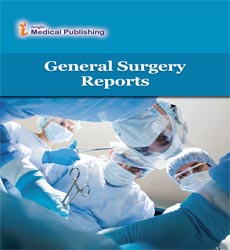The Role of Bariatric Surgery in Transplant Recipients and Candidates
Abeni Abidemi*
Department of Otolaryngology, Georgia Health Sciences University, GA, USA
- *Corresponding Author:
- Abiola Adedayo
Department of Otolaryngology,
Georgia Health Sciences University, GA,
USA,
E-mail: arman @gmail.com
Received date: November 13, 2023, Manuscript No. IPGSR-23-18475; Editor assigned date: November 15, 2023, PreQC No. IPGSR-23-18475 (PQ); Reviewed date: November 29, 2023, QC No. IPGSR-23-18475; Revised date: December 06, 2023, Manuscript No. IPGSR-23-18475 (R); Published date: December 13, 2023, DOI: 10.36648/ipgsr.7.03.142
Citation: Abidemi A (2023) The Role of Bariatric Surgery in Transplant Recipients and Candidates. Gen Surg Rep Vol.7 No.03:142.
Description
Grim corpulence and being overweight are a developing issue around the world. They also affect transplant recipients and patients with end-stage solid-organ disease. Bariatric medical procedure is the best accessible weight reduction strategy. Bariatric medical procedure can be useful for the therapy of certain circumstances, like nonalcoholic greasy liver illness or nonalcoholic steatohepatitis, which might prompt transfer and weight reduction, can improve or try and opposite them. In different cases, bleak heftiness is a constraint to getting to a transfer program, so bariatric medical procedure can act as a channel to relocate. After relocate, corpulence and weight related comorbidities can be a huge medical condition that might be dealt with, as in patients without a transfer, with bariatric medical procedure. There are a few explicit circumstances and issues to be viewed as in patients with endstage strong organ illness who are contender for bariatric medical procedure, like expanded grimness and mortality.
Surgical Treatment
Immunosuppressant regimens and technical limitations may also be significant after transplant. Contagious keratitis is one of the essential drivers of corneal visual impairment and eyeball misfortune in agricultural nations. Viable determination and therapy are generally postponed by a limit of clinical consideration. Up to 50% of serious contagious disease cases could bring about corneal hole and need restorative infiltrating keratoplasty. A major issue remains the scarcity of fresh donor corneas, particularly in emergency situations. Also, in correlation with corneal transplantation accomplished for visual purposes, the unite endurance rate is lower and careful entanglements are more continuous during intense disease. Alternative treatments for corneal perforations include amniotic membrane and umbilical cord patch, also known as ultra-thick AM. AM not only repairs the damaged corneal stroma but also reduces inflammation. However, it is important to consider the possibility of AM melting and fungal recurrence. Conjunctiva fold covering a medical procedure was presented by Gundersen in 1958. The wealth of blood and lymphatic vessels in conjunctival fold builds the opposition of cornea against parasitic contamination and collagenolysis. The use of CFCS to the treatment of headstrong FK has been ended up finding success. Notwithstanding, because of its structural flimsiness,CFCS alone utilized in punctured FK could bring about conjunctival fold disintegration and corneal hole repeat. We guess that blend of AMT and CFCS improves both structural help and hostile to irresistible impact. For the surgical treatment of corneal perforations in FK, we report the outcomes of AMT and CFCS.
Liver Transplantation
The improvement of computerized keen symptomatic and treatment innovation has opened endless new open doors for liver medical procedure from the period of advanced life systems to another period of computerized diagnostics, virtual medical procedure reproduction and involving the made situations continuously medical procedure utilizing blended reality. In this article, we discuss our efforts to create specialized software for three-dimensional visualization and reconstruction for advanced liver surgery and living donor liver transplantation. Moreover, we shared the new improvements in the field by making sense of the effort of the product from computer generated reality to expanded reality and blended reality. In any event, while careful preparation of a mind boggling liver activity is made and a given methodology is concluded by the group, its acknowledgment can be tested by the intraoperative discoveries. The surgical teams and the unit's prior experience will then be crucial to overcoming the new obstacles. By increasing the accuracy of planning and, as a result, the procedure's safety, new technologies will enable teams with less experience, particularly, to catch up to teams with more experience. The innovative advancements will assist the careful group with diminishing the gamble of careful complexities due to challenging to-perceive physical varieties and empower the group to continue inside specific safety buffers. Somewhat recently there have been various advances in complex liver medical procedure including careful information and abilities, and imaging methods. Three D remaking programming (3-DRS), 3D printing, augmented reality, expanded or blended reality utilizing PCs and committed programming to deliver 3D pictures to allude and yet again decipher radiological information progressively during intraoperative advances generally incredibly improved the exactness of this understanding, which lead to more secure and more effective preparation and execution of the surgery. Our internal and external validation of our experience developing and utilizing specialized 3D reconstruction software for ALS and LDLT is discussed in this review.
Open Access Journals
- Aquaculture & Veterinary Science
- Chemistry & Chemical Sciences
- Clinical Sciences
- Engineering
- General Science
- Genetics & Molecular Biology
- Health Care & Nursing
- Immunology & Microbiology
- Materials Science
- Mathematics & Physics
- Medical Sciences
- Neurology & Psychiatry
- Oncology & Cancer Science
- Pharmaceutical Sciences
